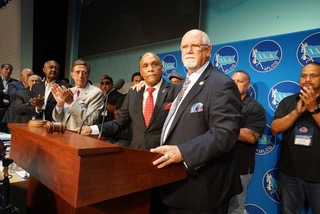

ILA Closely Monitoring West Coast Automation Battle as Total Terminal International This Week Announced Decision To Automate Its 385-Acre Pier T Terminal; ILWU Fighting Back To Protect Dockworker Jobs.
Read Journal of Commerce Report: https://www.joc.com/port-news/terminal-operators/latest-long-beach-terminal-automation-draws-ilwu-backlash_20210519.html
Bill Mongelluzzo, Senior Editor
TTI would become the fourth automated container terminal in Southern California. Total Terminals International’s (TTI’s) decision this week to automate its 385-acre Pier T terminal in Long Beach sets up a classic struggle between terminal operator employers and the International Longshore and Warehouse Union (ILWU).
The union opposes the project on the grounds it will eliminate some dockworker jobs, but employers say automation is needed to increase capacity and keep the ports of Long Beach and Los Angeles competitive.
“As the Long Beach Harbor Commission, the mayor of Long Beach, and the executive director of the Port of Long Beach consider TTI’s request, we ask that it carefully weigh the impacts that continued automation would have on American jobs and our local communities,” Danny Miranda, president of ILWU Local 94, said in a statement Wednesday.
Jim McKenna, president of the Pacific Maritime Association (PMA), which represents West Coast terminal operators in negotiating and administering the coastwide labor contract, told JOC.com the additional capacity brought by automating TTI Long Beach is crucial to stemming cargo diversions to other ports.
“In Southern California you’re almost at capacity.” McKenna said. “When you can’t handle cargo, the cargo leaves.”
Marine terminal automation, which involves replacing manually operated yard stacking cranes, yard tractors, and other cargo-handling equipment with driverless machines, is the most contentious issue facing longshore unions on the West and East coasts of North America. It will almost certainly be an issue again next spring when the ILWU and PMA launch negotiations to replace the current contract that expires on July 1, 2022.
The road to automation TTI would become the fourth automated terminal in Southern California. Long Beach Container Terminal (LBCT) and TraPac in Los Angeles are fully automated, meaning all cargo-handling functions in the container yards — but not ship-to-shore cranes — are conducted with driverless equipment. APM Terminal’s Pier 400 project involves automation of 100 acres at the 440-acre facility through the use of automated straddle carriers that shuttle containers within that portion of the facility.
ILWU Local 10 in 2019 tried unsuccessfully to convince the city of Los Angeles to block a construction project for the APM Terminals automation project.
TTI was not immediately available for comment, but its project will be a fully automated facility on the scale of LBCT, according to people familiar with the project who asked to remain anonymous. As required by the coastwide contract when an individual employer decides to automate, TTI met Monday with leaders of the three ILWU locals in Southern California to lay out the details of its automation plan.
The locals will now provide their input, observations, and suggestions on the plans, but according to the terms of the coastwide contract that was signed in 2008, the ILWU cannot block the project, McKenna told JOC.com Wednesday. However, the coastwide contract calls for an exchange in which both parties have certain obligations they must meet to make a path forward for automation, said Frank Ponce De Leon, ILWU coast committeeman.
“Absent adherence to that quid pro quo, there is no outright, one-way grant of automation to the employers,” he told JOC.com. McKenna said the PMA was represented at Monday’s meeting, even though all decisions on automating TTI will be made at the local level. McKenna said the ILWU representatives listened closely to the plans and “a lot of good questions were asked.”
Past experience in Southern California demonstrates that automated cargo-handling equipment can eliminate 40 to 70 percent of existing jobs. However, automation also creates new jobs associated with the installation and maintenance of electrified equipment, programming, and related functions that are not present in a manual environment.
If the project moves forward, the ILWU is expected to claim jurisdiction over the newly created jobs. McKenna also emphasized that cargo volumes will continue to grow at the largest US port complex, and experience has shown that will result in increased jobs.
“If you handle twice as much cargo, that’s a lot of cargo and a lot of jobs,” he said. Higher volume and more coming The Los Angeles-Long Beach port complex handled more than 17.3 million laden and empty TEU in 2020, according to figures provided by the ports.
The busiest US container gateway has handled an average of 854,802 TEU of imports from Asia in each of the past 10 months, up from an average of 636,424 TEU in the previous 10 months, according to PIERS, a JOC.com sister product within IHS Markit. Retailers and freight forwarders project similar volumes at least through the summer–fall peak shipping season this year.
Larry Nye, vice president of port planning at the infrastructure advisory firm Moffatt & Nichols told JOC.com Wednesday that based on conservative growth projections of about 4 percent per year, Los Angeles-Long Beach will reach its full capacity of about 23 million to 25 million TEU per year by 2027–28, unless terminals densify their operations.
In this context, densification is synonymous with automation, which enables the terminals to stack containers higher and wider without compromising efficiency, he said. For example, the fully automated LBCT facility later this year will complete the third and final phase of its expansion, giving it an annual throughput capacity of 3.4 million TEU, according to LBCT, which is one of six container terminals in Long Beach. The entire port handled 8.1 million laden and empty TEU last year, according to Port of Long Beach statistics.
Not all terminals will choose to densify. Rather, those that do will balance the high costs associated with automation — $1.4 billion in the case of LBCT — and the efficiencies and reduced labor costs inherent in automation, Nye said. However, whereas LBCT had the luxury of beginning its project a decade ago on a large parcel of vacant land, TTI will be challenged by installing automation while it continues to handle large cargo volumes each day.
TTI will have to automate in phases, which means taking 40 to 50 acres out of use during each phase, a process that could take 10 years, Nye said.
Contact Bill Mongelluzzo at [email protected] and follow him on Twitter: @billmongelluzzo.
